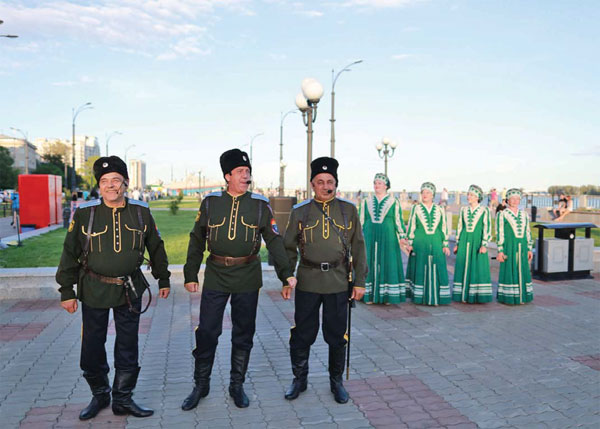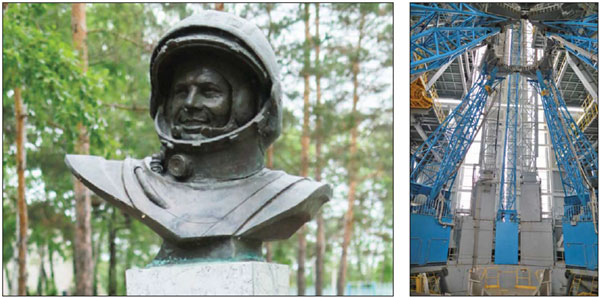A look inside a lucrative launchpad
Updated: 2016-09-23 07:58
By Ren Qi(China Daily Europe)
|
|||||||||
Eastern Spaceport in far east Russia opens its doors to the world, but don't press ny buttons
Someone played the Star Wars theme music on their mobile phone when we stepped into the Vostochny Cosmodrome, at the Eastern Spaceport in far east Russia.
Although Baikonur Cosmodrome, the Earth's first and largest operational space launch facility, still belongs to Russia after the dissolution of the Soviet Union, the government needs to pay a $115 million annual lease for the site to Kazakhstan until 2050.
|
A public performance in Blagoveshchensk's main square, which is a river away from the Chinese city of Heihe. Photos by Ren Qi / China Daily |
|
From left: A statue of Yuri Gagarin at the Eastern Spaceport. Inside the rocket launch tower. |
Located in the Tsiolkovsky town of Amur Oblast, the Vostochny spaceport was constructed on the orders of Russian President Vladimir Putin in 2007 to reduce dependency on Baikonur. The first launch from the new base was made in April.
Alexander Molchanov, deputy general of the Eastern Spaceport, tells me I was the first Chinese correspondent to visit the mysterious site since its construction.
Olga is a guide at a small museum in the spaceport and she explains why the place is so mysterious. She says the city where we stood was called Uglegorsk, which means coal hill, in the 1960s.
"But there is no coal here," she says with a smile. "The name was just a cover, as the place was established in order to serve the nearby intercontinental ballistic missile base of the Soviet Armed Forces.
"Then in September 2015, the city changed the name to Tsiolkovsky in honor of the founder of theoretical astronautics, Konstantin Tsiolkovsky, and no one had expected Chinese correspondents to visit the site so soon," Olga says.
A vehicle took me through forests, grassland and some construction sites, and finally I arrived at the rocket and spacecraft assembling facility.

"In order to keep safe and not get lost, you can visit any corner but don't open any closed doors or press any buttons on the machines," Molchanov tells me. He says no one who works there is in the military, and that Russia wants the spaceport to be known to the world.
Then I walked in, and was shocked by the huge rocket-assembling equipment, which is more 30 meters long and 5 meters high. I noticed every machine in the room was extremely clean, with no dust even on the highest surface.
"The temperature and humidity in this assembling facility is strictly controlled, and the need for cleanliness is extremely high as well," Molchanov says. "Some parts of the facility are even cleaner than a hospital operating theater."
Four kilometers from the facility, I was taken to the 53-meter-high rocket launch tower. I didn't see any heavy security at the 1,600-metric-ton tower, which stands in a wide field.
Molchanov points at the tower, saying there will be a second launch there in July or August 2017, and a manned spacecraft is expected to be launched in 2018.
The aerospace industry was the pride of the former Soviet Union. Now, in spite of a troubled economy, Russia maintains that pride. I see a statue of Yuri Gagarin, the first man in space, in the yard of the spaceport. The whole country, government and people, hope to rebuild the nation's leading role in space exploration by having this new rocket launching center.
Alexander Kozlov, governor of Amur Oblast, tells me the new spaceport can generate an income of $9.2 million per year and provide more than 2,000 jobs.
Russian media once called the Eastern Spaceport the most ambitious large-scale construction project in modern Russia.
US magazine Foreign Affairs published a comment piece, Russia Seeks Far East realignment: Domestic Initiatives in December, saying the construction of the Eastern Spaceport shows the ambition of President Putin to develop Russia's far east, with the expectation that it will stimulate the Russian economy.
During my half-day visit, I was repeatedly told the Eastern Spaceport, as well as the whole aerospace industry in Russia, welcomes any cooperation with other countries, such as China and European nations.
Wu Fei, a researcher from the Center for China and Globalization, tells me Russia is looking forward to working together with the European Union on aerospace, as it is the only industry that can slip the leash from the United States if they start to cooperate. By cooperating with the EU, Russia is able to obtain research funding from Europe.
Moreover, Russia can improve its image in Europe if it makes progress in aerospace research, Wu says.
Contact the writer at renqi@chinadaily.com.cn
(China Daily European Weekly 09/23/2016 page7)
Today's Top News
ODI led for first time by private firms
Nanjing's culture and creativity on display in London
State of emergency declared in US city amid protests
Universities given boost in rankings
Demand for Mandarin rises in UK
China 'capable of keeping medium-to-high growth'
Li tells Obama of opposition to THAAD deployment
Greek vows to improve refugee situation on island
Hot Topics
Lunar probe , China growth forecasts, Emission rules get tougher, China seen through 'colored lens', International board,
Editor's Picks

|

|

|

|

|

|









